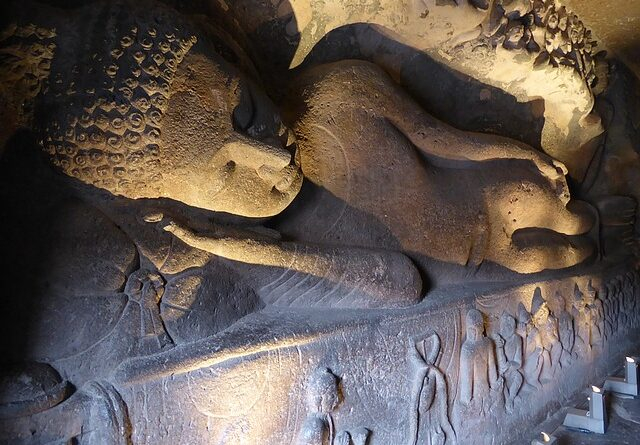Swachh Iconic Places (SIP)
Context:
Taking forward the vision of Prime Minister, for transforming iconic heritage, spiritual and cultural places in the country as ‘Swachh Tourist Destinations’ under Swachh Iconic Places (SIP) initiative of Swachh Bharat Mission Grameen (SBM-G), the Department of Drinking Water and Sanitation (DDWS), Ministry of Jal Shakti has announced the selection of the following Twelve (12) iconic sites under Phase IV of SIP.
- Ajanta Caves, Maharashtra
- Sanchi Stupa, Madhya Pradesh
- Kumbhalgarh Fort, Rajasthan
- Jaisalmer Fort, Rajasthan
- Ramdevra, Jaisalmer, Rajasthan
- Golconda Fort, Hyderabad, Telangana
- Sun Temple, Konark, Odisha
- Rock Garden, Chandigarh
- Dal Lake, Srinagar, Jammu & Kashmir
- Banke Bihari Temple, Mathura, Uttar Pradesh
- Agra Fort, Agra, Uttar Pradesh
- Kalighat Temple, West Bengal
The initiative aims at enhancing the experience of both domestic and foreign visitors by improving the sanitation and cleanliness standards at and around the sites.The objective of SIP is to achieve a distinctly higher level of Sanitation/Cleanliness at these places, especially on the peripheries and in approach areas. This project is being coordinated by the Department of Drinking Water and Sanitation (DDWS), Ministry of Jal Shakti in association with the Ministry of Housing and Urban Affairs (MoHUA), Ministry of Tourism, Ministry of Culture and the concerned State/UT governments.
About SIP:
- This initiative was launched in 2016 under Swachh Bharat Mission.
- It was initiated as project to implement Prime Minister’s vision to take iconic places and their surroundings to higher standards of cleanliness (swachhata), so that all visitors benefit and also take away home message of cleanliness.
- Implementation of SIP:
- It is collaborative project of Ministry of Drinking Water and Sanitation with three other central Ministries:
- Ministry of (M/o) Housing and Urban Affairs,
- M/o Culture, and
- M/o Tourism.
- It also involves local administrations in concerned states and public sector and private companies are also sponsoring partners.
- It is collaborative project of Ministry of Drinking Water and Sanitation with three other central Ministries:
- Initiatives taken up under SIP:
- Improved sewage infrastructure, installation of Sewage Treatment Plant (STP), drainage facilities, improved sanitation facilities, water vending machines, solid and liquid waste management (SLWM) set-up, structure restoration, lighting arrangements, beautification of parks, roads maintenance, better transport facilities in approach and access areas besides at the main sites.
Phase I coverage of iconic places
Under Phase 1 of this initiative, the following iconic places are being covered for an intensive clean up.
- Vaishno Devi, Jammu and Kashmir
- Chhatrapati Shivaji Terminus, Maharashtra
- Taj Mahal, Uttar Pradesh
- Tirupati Temple, Andhra Pradesh
- Golden Temple, Punjab
- Manikarnika Ghat, Varanasi, Uttar Pradesh
- Ajmer Sharif Dargah, Rajasthan
- Meenakshi Temple, Tamil Nadu
- Kamakhya Temple, Assam
- Jagannath Puri, Odisha
Phase II coverage of iconic places
The Phase II of Swachh Iconic Places initiative covers the following.
- Gangotri
- Yamunotri
- Mahakaleshwar Temple, Ujjain
- Char Minar, Hyderabad
- Church and Convent of St. Francis of Assissi, Goa
- Adi Shankaracharya’s abode Kaladi in Ernakulam
- Gomateshwar in Shravanbelgola
- Baijnath Dham, Devghar
- Gaya Tirth in Bihar
- Somnath temple in Gujarat.
Phase III coverage of iconic places
- Raghavendra Swamy Temple (Kurnool, Andhra Pradesh)
- Hazardwari Palace (Murshidabad, West Bengal)
- Brahma Sarovar Temple (Kurukshetra, Haryana)
- VidurKuti (Bijnor, Uttar Pradesh)
- Mana village (Chamoli, Uttarakhand)
- Pangong Lake (Leh-Ladakh, J&K)
- Nagvasuki Temple (Allahabad, Uttar Pradesh)
- ImaKeithal/market (Imphal, Manipur)
- Sabarimala Temple (Kerala)
- Kanvashram (Uttarakhand)
Source: Swachh Bharat Mission
Discover more from Simplified UPSC
Subscribe to get the latest posts sent to your email.


